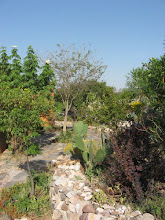
After a long Dry Season (See: Land and Seasons), we have now had two weeks and over 5 inches of Rain. Dry Season starts when the Rains Stop. Usually, this is sometime in September. Last year, the Season started at the beginning of September, stopping a couple of weeks short of normal. Usually some time during the months of the Dry Season, there are traditional rain periods; often, a few days in November, a couple in February and/or March. This past Season was marked not only be its early beginning but, also by its lack of "traditional" rain breaks. Besides the lack of rainfall, the daytime temperatures were also hotter than usually, for a longer period of time. It was a topic, in every conversation I had with my neighboring villagers. "Que calor! (How hot it is!), Cuando viene la lluvia? (When is the rain coming?)."
This made of a long wait for the rains. It meant more watering; and more considered use of gray water. For the campesinos, it meant having their cornfields ready to plant, but not having a starting date. This last, because, traditionally, the corn is planted after the rains have soaked down a few inches into the clay soil; and this takes a few rains to accomplish.
While they were waiting for the rains, the farmer-campesinos used various forms of rain requesting, depending on their faith-orientation. Most farmers are Catholic by upbringing and part-Native American by birthright. The Catholic part followed the religious traditions of petitioning God in specifically designated masses. The "indio" (i.e., Native American) part performed dances for and set of fireworks and rockets to the gods/God, in the folk tradition.
It would appear that the prayers/petitions were answered. Now we have had an abundance of rain and those who were first to plant their corn (everyone has a mini-tradition as to the exact appropriate time), are seeing the first corn shoots breaking through the soil.
And the cornfields are not the only place that Green is breaking through. Grasses are emerging everywhere. And this includes everywhere in our Garden, as well; though we call them weeds, there. And the Nopal cactus paddles that had looked drawn, almost dessicated, two weeks ago, have plumped right up and the new leaves will be ready for making side dishes, filling, or salads. And their fruit, the prickly pears (called "tunas," here) are filling out and will be ready to eat raw or to be used in making jams or desserts.
Inside Casita Dos Arbolitos Walls, the Gardens have plumped up as well. Things that were taking their time to while the rains failed to appear, have had growth spurts or have stepped up production. Our squash plants, which were being well watered, seemed to wait until the rains to burst out with flowers and fruit. Our fig tree, which was giving us a few figs every couple of days, is producing about a pound of ripe figs per day, now. Back outside the Walls, plants like the una de gato and trees like the palo dule are starting to send out leave buds. With Summer, the Rainy Season has arrived and the High Plateau is turning Green.
Whether the rains have come as part of a cycle, the whims of nature or as petition to the gods or God, there is beauty emerging as these high drylands turn from dusty golden varying shades of greens, with blushes of ripening. One afternoon, as the clouds were passing overhead and bringing showers, there were enough spaces in between the clouds to allow the Sun to get some light through. And with the light came the arco de Iris, a rainbow. I'm sure many of the petitioners took it as a sign that their prayers had been heard and affirmatively answered.
